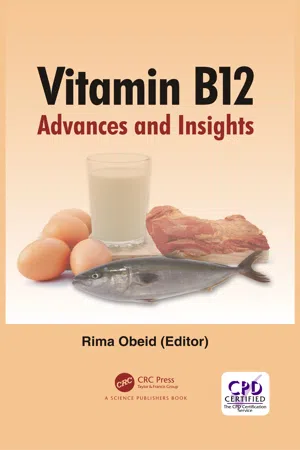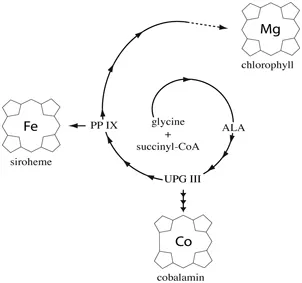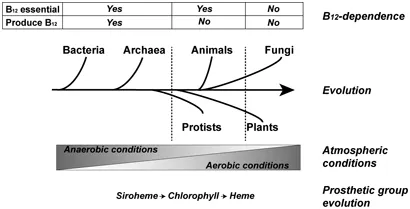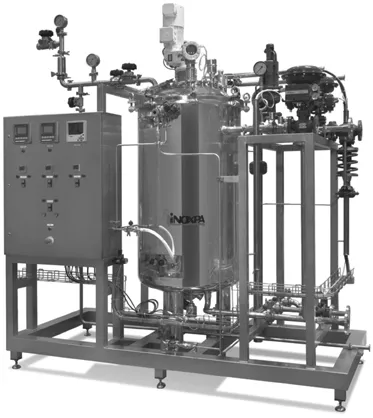![]()
Contents
Dedication
Preface
1. Milestones in the Discovery of Pernicious Anemia and its Treatment
Jörn Schneede
2. Nutritional and Biochemical Aspects of Cobalamin Throughout Life
Eva Greibe
3. Intracellular Processing and Utilization of Cobalamins
Luciana Hannibal and Donald W Jacobsen
4. Inherited Defects of Cobalamin Metabolism
David Watkins and David S. Rosenblatt
5. Conditions and Diseases that Cause Vitamin B12 Deficiency: Form Metabolism to Diseases
Emmanuel Andrès
6. Vitamin B12 Deficiency in Developing and Newly Industrialising Countries
Chittaranjan Yajnik, Urmila Deshmukh, Prachi Katre and Tejas Limaye
7. Vitamin B12 in Neurology and Aging
Andrew McCaddon and Joshua W Miller
8. The Role of Cobalamin in the Central and Peripheral Nervous Systems: Mechanistic Insights
Elena Mutti
9. Laboratory Markers and Diagnosis of Cobalamin Deficiency
Rima Obeid
10. Cobalamin During Pregnancy and Lactation
Rima Obeid, Pol Solé-Navais and Michelle M Murphy
11. Vitamin B12 After Birth and During Early Life
Rima Obeid, Pol Solé-Navais and Michelle M Murphy
12. Cobalamin—Folate Interactions
Pol Solé-Navais, Rima Obeid and Michelle M Murphy
13. Extreme Vitamin B12 Concentrations in Clinical Practice in the Absence of Symptoms or B12 Treatment
Rima Obeid
14. Vitamin B12 and Drug Development
Jayme L Workinger and Robert P Doyle
Index
![]()
Dedication
To my son, Jean-Paul
![]()
Preface
Cobalamin(s) (vitamin B12) have been known for 100 years. Key milestones in the study of cobalamin have been through over 10 decades of trial and error, research and discoveries. Remarkable discoveries in the field have saved many lives and were awarded 2 Nobel Prizes; Minot and Murphy (Nobel Prize in Physiology or Medicine 1934) and Dorothy Hodgkin (Nobel Prize in Chemistry 1964). Still, cobalamin constitutes an amazing area of research with many undiscovered facets.
The health relevance of cobalamin became evident long before discovering its chemical entity. Liver extracts containing few micrograms of the healing factor, cobalamin, were used in the 1920s up to the early 1930s as a life-saving medication against fatal pernicious anemia. The purification and production of large quantities of the ‘liver factor’ were real challenges, but the biggest challenge was for patients to eat these extracts as an alternative to death. Now that cobalamin has become available as over-the-counter supplements, or as injections containing a few micrograms to milligrams, its relevance to health and disease has gained more importance over the time. Cobalamin’s ‘lifting effect’ has been experienced by millions of patients and doctors. Today, the impact of cobalamin on human health has changed from ‘treating a severe disease’ to ‘prevention of a yet not-manifested condition’. The meaning of cobalamin has now taken new dimensions on a population level after implementing modern laboratory diagnosis tests. Using modern biomarkers has shown that subclinical cobalamin deficiency affects many individuals in critical life phases.
‘Vitamin B12: advances and insights’ is an extract of knowledge of experienced scientists who have been working on nutritional, structural, chemical, and clinical aspects of the vitamin. This book has introduced an innovative and unclassical approach by addressing ‘gaps in knowledge’ that surround the topic. These gaps are identified by scientists who are very close to the cobalamin epi-center and intended to provide a direction for future research.
The book is an in-depth study on the vitamin from basic science to modern health challenges. Early knowledge on cobalamin in the light of recent scientific discoveries (Chapter 1); Dietary requirements and nutritional supply (Chapter 2); Cobalamin uptake and intracellular processing (Chapter 3); Congenital cobalamin disorders (Chapter 4); Acquired causes of cobalamin deficiency and clinical consequences (Chapter 5); Cobalamin deficiency: a public health problem in developing countries (Chapter 6); The role of cobalamin in the nervous system, its relevance to brain aging, and potential mechanisms surrounding this area (Chapters 7 and 8); Cobalamin deficiency biomarkers and diagnosis (Chapter 9); Cobalamin deficiency in critical age phases such as pregnancy, lactation and early life (Chapters 10 and 11); Cobalamin deficiency in the era of folic acid fortification (Chapter 12); Cobalamin unexplained extreme values in clinical practice (Chapter 13); the role of Cobalamin in drug transport and development (Chapter 14).
The target audience for this book are experts and researchers looking for in-depth knowledge in the above mentioned areas of cobalamin science; health care providers who take part in diagnosis, treatment, and prevention of deficiency conditions; policy makers who can influence implementation of diagnosis tools or nutritional policies on a country and population levels; and stakeholders and pharmaceutical companies who are interested in producing diagnosis tools, supplements, fortified foods or other pharmaceutical products that use cobalamin as a drug carrier.
This book is by no mean a complete documentation of what is going on around the topic. However, it constitutes an attempt to grasp the current knowledge on a few areas related to cobalamin and to provide insights into unexplored questions and issues.
![]()
1
Milestones in the Discovery of Pernicious Anemia and its Treatment
Jörn Schneede
Overview
Pernicious anemia (PA) is a serious form of vitamin B12-deficiency. Vitamin B12 belongs together with heme and chlorophyll to the tetrapyrrole family (Figure 1) (Yin and Bauer 2013). Vitamin B12 is an evolutionarily ancient (≈ 3.8 x 109 years old) cofactor that was responsible for energy production through fermentation of small organic molecules in the absence of exogenous electron acceptors in the prokaryotic anaerobic world (Figure 2) (Santander et al. 1997). In the course of evolution siroheme later allowed making use of inorganic electron acceptors, before oxygen production by chlorophyll made aerobic respiration through heme possible. Almost 1% of the genome of S. typhymurium is dedicated to vitamin B12 synthesis and transport (Roth et al. 1996). Though being one of the structurally most complex, non-polymeric biomolecules synthesized by nature, eukaryotic organisms do not produce B12 (Figure 2). As a consequence, this vitamin is essential for human metabolism, albeit only required in trace amounts (possibly as low as 1 μg/d, while the recommended daily allowances in adults are 2.4 μg/d) and functions as cofactor in only two enzymes, methionine synthase and (R)-methylmalonyl-CoA mutase (Helliwell et al. 2011). The remarkable discovery of vitamin B12 was only possible and proceeded by the endeavor to find effective treatment options for PA, one of the conditions causing severe vitamin B12-deficiency. The scientific progress was, however, slow and stretched over a period of almost 200 years from the first description of PA, to the evolution of theories about possible causes and ultimately the invention of effective treatments. The search for effective treatment options also resulted in the resolution of the pathogenesis of pernicious anemia and ultimately the discovery of B12. Through isolation of an unknown extrinsic factor from liver extracts that was accountable for clinical response in pernicious anemia patients it was eventually possibly to elucidate the chemical structure of vitamin B12. In parallel, efforts were started to map the production of vitamin B12 in certain bacteria. The elucidation of the chemical pathways of bacterial production of the vitamin finally made the complete synthesis of the vitamin in the laboratory possible. This enterprise has sometimes been called “Mount Everest of biosynthesis” and it was not before in 2013 that the complete anaerobic pathway of B12-synthesis had been charted (Moore et al. 2013). All in all, vitamin B12 research has resulted in two Nobel prizes-so far. Notwithstanding these achievements, synthesis of the vitamin in the laboratory is far too complicated and resource-demanding for commercial purposes and large-scale industrial production of vitamin B12 is still carried out by aerobic fermentation using Pseudomonas denitrificans (Xia et al. 2015) (Figure 3).
The course of history of vitamin B12 can arbitrarily be divided into different eras and stages (Figure 4). During this journey different therapeutic approaches for the treatment of vitamin B12-deficiency were developed, first oral therapy with raw liver, then oral or parenteral administration of liver extracts, followed by more refined liver concentrates that could be injected or taken by mouth with and without addi...



